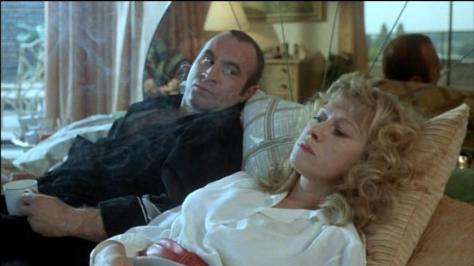By Dennis Hartley
(Originally posted on Digby’s Hullabaloo on June 14, 2014)

School daze: Palo Alto
It’s tempting to call Gia Coppola’s directing debut, Palo Alto, a Hollywood home movie. Her mom (Jacqui Getty) is in the cast, as well as her cousin (Bailey Coppola) and her great aunt (Talia Shire). Another cousin (Robert Schwartzman, brother of Jason and son of Talia) is co-credited for the music. And her granddad (do I need to tell you who he is?) has a voice over cameo (unbilled). But I won’t do that; I will maintain professional integrity, and judge her film strictly on its own merits (are you buying this?).
Okay, one more thing I should give you a heads up on. Coppola’s film revolves around the travails of bored, mopey, privileged teenagers, which puts her at risk being accused of riding aunt Sofia’s coattails. Again, I won’t go there.
While the film is an ensemble piece about a group of northern California high school students, there is a protagonist. Her name is April (Emma Roberts, daughter of Eric). Saddled with the mantle of “class virgin”, April is a sensitive and withdrawn senior who plays on the soccer team.
As her hormones begin to burble and roil, exacerbated by peer pressure from her sexually active girlfriend Emily (Zoe Levin), April finds herself conflicted by a dual attraction to her coach (James Franco) and more age-appropriate classmate Teddy (Jack Kilmer, son of Val…who plays April’s dad). Emily has already taken Teddy for a test drive, as well as his best bud Fred (Nat Wolff), a surly James Dean type (we know this due to his tell-tale red jacket).
Coppola adapted her screenplay from cast member Franco’s book, Palo Alto: Stories. I haven’t read it, but a critic from Publisher’s Weekly certainly has. Here’s their conclusion:
The overall failure of this collection has nothing to do with its side project status and everything to do with its inability to grasp the same lesson lost on its gallery of high school reprobates: there is more to life than this.
Working from the assumption this is an accurate assessment of the source material, I can say that Coppola has made a film that is pretty faithful to the book (if you catch my drift). Roberts has a compelling presence, and Kilmer’s River Phoenix vibe will serve him well in future endeavors, but the narrative has been done to death, and with much more style and originality (try renting Foxes, Kids, Ghost World, Election, or River’s Edge instead).

I was a teenage anarchist: We Are the Best!
It may seem counter-intuitive to ascertain that We Are the Best! (or any movie about punk rockers) is “endearing” but you’ve just got to love a rhyming couplet that matches up “morgue” with “Bjorn Borg”. That’s a line from “Hate the Sport”, written by 13 year-old friends Bobo (Mira Barkhammer) and Klara (Mira Grosin).
The city is Stockholm, the time is the early 1980s, and Bobo and Klara really hate P.E. class, which has inspired the pair to sign up for time at their school’s rehearsal space on a whim, so they can compose their punk anthem. While the space comes equipped with a drum kit and bass guitar, there is one drawback…neither of the girls knows how to play an instrument. But they do have the ethos (besides, Klara already sports a Mohawk) so they’re already halfway there.
Ostracized by their classmates for their tomboyish looks and demeanor, Bobo and Klara have formed their own social club of two. While Bobo is brooding and introspective, Klara is the more brash and outspoken of the pair. Klara also attaches great importance to maintaining one’s punk cred (in one particularly amusing scene she laments about her older brother being a “sellout” because he’s started listening to Joy Division).
Still, attitude and cred alone will only get you so far if you really want to actually start making music, so how should they go about learning a chord or two? Salvation arrives in the unlikely guise of classically trained guitarist Hedwig (Liv LeMoyne), whom they espy performing in their school’s talent show. She is a devout Christian…but nobody’s perfect.
The trio of young leads have wonderful chemistry, and are able to telegraph those vacillating jumps between vibrant exuberance and painful awkwardness in a very authentic manner.
I should warn parents that while I refer to the film as “endearing”, and would definitely consider it “girl power-positive”, I wouldn’t call it “family friendly” (it’s labelled with the nebulous “NR”, but has plenty of R-rated dialog).
Writer-director Lukas Moodysson (who adapted the screenplay from a comic book created by his writer-musician wife, Coco) has fashioned an entertaining dramedy that nicely encapsulates the roller coaster of emotions that define the early teen years.



















